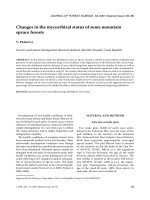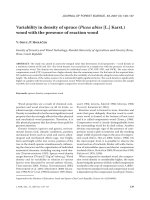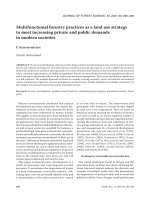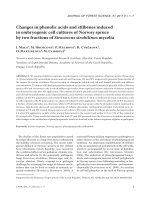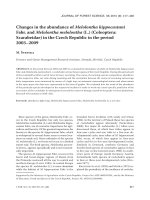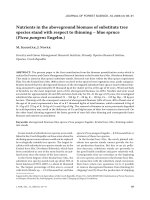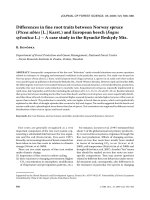Báo cáo lâm nghiệp: "Coppice-with-standards in floodplain forests – a new subject for nature protection" potx
Bạn đang xem bản rút gọn của tài liệu. Xem và tải ngay bản đầy đủ của tài liệu tại đây (371.48 KB, 6 trang )
306 J. FOR. SCI., 55, 2009 (7): 306–311
JOURNAL OF FOREST SCIENCE, 55, 2009 (7): 306–311
e floodplain landscape belongs to the youngest
geological, geomorphological, and landscape forma-
tion in Europe. Both the origin and the development
of floodplain landscapes in Central Europe have been
the subject of a long-term study (for an overview see
e.g. R 1994). During the prehistoric period and
the Middle Ages, the floodplain landscape was sub-
jected to extensive settlement and served simultane-
ously as an important communication and migration
space (see O 1983; P 1999) leaving
no doubt that humans had an essential influence on
the formation of floodplains in Europe (R
2001). e natural ecosystems of Central European
floodplains, which were predominantly covered by
floodplain forests, were very strongly influenced
by humans during the whole of the Holocene. e
anthropogenic conditionality of the formation and
development of floodplain forest ecosystems has
lead to their present understanding as so-called
archaeocoenoses (Ř 2001). From the view-
point of European biodiversity, the floodplain for-
ests are considered immensely valuable habitats
(W et al. 1990; K, H 2001). e
floodplain forests were usually managed in the silvi-
cultural system of coppice-with-standards. Accord-
ing to K (1931), this forest type is defined as
“a mixture of coppice and high forest of seed origin”.
e forest stand of coppice-with-standards usually
consists of two storeys: the understorey is created
by coppice and the overstorey composes of big trees
of generative origin (so-called standards or reserved
trees) (M 1992).
e coppice-with-standards system was presum-
ably developed in France, where it was designed by
J. B. Colbert for Louis XIV, king of France, between
1664 and 1683. e aim was to fulfil the triune func-
tion of the king’s forests: (1) production of strong
oak trunks used for building and navy, (2) produc-
tion of firewood and timber, and charcoal, (3) pig
grazing on acorns from the mature oaks of the top
Supported by the Ministry of Environment of the Czech Republic, Project No. SP/2d4/59/07 Target Management of Endangered
and Protected Organisms in Coppices and Coppice-with-standards under the Natura 2000 System.
Coppice-with-standards in floodplain forests – a new
subject for nature protection
I. M
Department of Biology, Faculty of Education, Palacký University in Olomouc, Olomouc,
Czech Republic
ABSTRACT: At present, the coppice-with-standards system has become so rare in floodplain forests that it is consid-
ered a natural monument. In 1990, the coppice-with-standards system was not recorded in the territory of the Czech
Republic. is state contradicts the increasing interest of nature protection organizations in the relict remainders of the
coppice-with-standards system, which is to be considered the closest to naturally preserved lowland forest type, and is,
therefore, recommended as the final state of the biocentres and biocorridors in today’s floodplain forests. e aim of
this paper is to present the results of the inventory dealing with the present occurrence of the coppice-with-standards
system in the floodplain forest of the Litovelské Pomoraví Protected Landscape Area (PLA) in a historical context.
Keywords: coppice-with-standards; floodplain forest; forest management; storeyed high forest
J. FOR. SCI., 55, 2009 (7): 306–311 307
stand layer. e features of the coppice-with-stan-
dards silvicultural system with prevailing oak in the
top layer and coppice in the bottom layer proved
very interesting from an economic point of view,
and the coppice-with-standards form remained in
use in many floodplain forests of Central Europe
until the first half of the 20
th
century (M
1956). Regarding its character, production, silvicul-
ture and biodiversity, the coppice-with-standards
forest represents a valuable, close-to-nature forest
management object. At present, however, the cop-
pice-with-standards system has become so rare in
floodplain forests that it is considered a natural
monument (M et al. 1992). e coppice-with-
standards forest has had a long tradition in Czech
lands. Within the territory of the present Czech
Republic, the coppice-with-standards silvicultural
system was most common around 1900, when it
took up almost 3% of the total area, which was ca
60,000 ha at that time (figures from the Reambulated
Cadastre), primarily in Moravia. In 1990, the cop-
pice-with-standards system was not recorded in the
territory of the Czech Republic (K 2007). is
state contradicts the increasing interest of nature
protection organizations in the relict remainders
of the coppice-with-standards system, which ac-
cording to M (1998) is to be considered the
closest to naturally preserved lowland forest type,
and is, therefore, recommended as the final state of
the biocentres and biocorridors in today’s floodplain
forests.
e aim of this paper is to present the results of the
inventory dealing with the present occurrence of the
coppice-with-standards system in the floodplain for-
est of the Litovelské Pomoraví Protected Landscape
Area (PLA) in a historical context.
METHODS
e presented case study was carried out in the
floodplain forests of Litovelské Pomoraví, which is
located within the floodplain of the Morava River
(Upper Moravian Vale, the Czech Republic). In the
typology of the Forest Management Institute, this
type of forest geobiocoenosis belongs to the first
forest altitudinal zone (P 2000), which corre-
sponds to the second vegetation zone according to
Z (1976). e prevailing forest type groups
are elm ash weed plain, from the geobiocoenologi-
cal viewpoint Ulmi Fraxineta carpini of the higher
order. In the flooded areas, various biotope types are
present depending on the distance from the river and
duration of flooding (willow alder carr, poplar plain,
etc.). For detailed characteristics of the floodplain
forest geobiocoenoses in Litovelské Pomoraví see
M (2008b).
In the course of this study, research was carried
out in situ to confirm the initial hypothesis which
postulated the presence of the coppice-with-stand-
ards system among the groups of stands that are de-
scribed as layered although ranked among the high
forest types in the forest management plan. Based
on the data from the forest management plans, all
the layered stand groups within the study area were
recorded on the working maps and then were visu-
ally examined in the field in 2007. e result of the
research is a summary map of the study area which
indicates those stand groups that preserved the
features of the coppice-with-standards silvicultural
system.
RESULTS
Historical development of the coppice-with-
standards forest type in the floodplain forest
of Litovelské Pomoraví
ere are many written documents in the account
books of the City of Olomouc (which was the owner
of the forests from the 16
th
century until 1950, when
the forests were taken over by the state) which can
be used for the study of the historical development of
the floodplain forests in Litovelské Pomoraví (H
1985). Since 1992, the City of Olomouc has been in
charge of its historical property once again. As the
accounting documents from the 16
th
century show,
the city gained substantial revenue from wood and
acorns, while in the fertile years, revenues from the
sale of acorns were up to twice as high as the rev-
enues earned from the sale of wood. is permits
the assumption of a high abundance of oak in the
floodplain forest at that period. Intensive grazing
was common in the floodplain forest until around
1850, when it was officially abolished. In 1754, the
city forests were geodetically located and their first
taxation dates back to 1795. e forest management
plan concerning the middle forest was elaborated
based on age-class divisions with a rotation period
of 25 years. Additionally, precise maps were drawn.
e map of the Březová forest district contains a note
stating that there is no non-stocked forest land in the
district and that almost the whole area is regularly
flooded by the Morava River, which, however, does
not interfere with the growth of the stand. e notes
further state that more attention should be directed
towards the plantation of oak, because seeding with
acorns was rarely successful and when attempted in
the clear-cut areas, the saplings could not compete
308 J. FOR. SCI., 55, 2009 (7): 306–311
with the coppice shoots. For the same reason, a for-
est tree nursery for oak transplants was set up in the
Březová forest district. In a similar way, notes related
to the Horka forest district state that the whole area
up to the plough-land at Daliboř locality was regu-
larly flooded. e floodings were often so high that
it was possible to sail the forest in a boat.
Jan Pawost, the author of the management plan,
master of the hounds, also noted that it was necessary
to pile the wood properly. Oak saplings of the height
of an adult person were planted. e land-register of
the city property from 1784 describes a coppice-with-
standards system in Litovelské Pomoraví, where the
standards were present in ca 1/3, the rest consisted of
coppice and softwood. In the floodplain near Horka
nad Moravou with an area of 207 ha, the upper stand-
ard layer covered half the area. Stand groups with oak
up to 400 years of age were by no means exceptional.
e next management plan was drawn up in 1833
(head forester Antonín Prokop Schwarz). Schwarz
draw up the management plan in the form of the area
control method with a rotation period of 35 years,
while emphasizing firewood production from the
coppice. e oak was a dominant woody species
strongly prevailing in both the forest districts, which
composed the upper layer that was 300–400 years
old, together with ash, elm and lime. e rotation
period for the oak standards was set at 150 years, for
the ash and elm standards it was 70 years. e oldest
oak standards in the Březová forest district were as
old as 586 years. e dominance of the oaks was as-
sessed negatively by Schwarz, because they inhibited
coppice growth which was the main subject of inter-
est. e forest management means were recorded in
detail; documentation since 1869 has been preserved.
For example, between 1869 and 1939 more than
1.5 million transplants consisting of oak (27.5%), ash
(23.5%), alder (27.6%), birch (11.6%), locust (1.4%),
elm and maple (each 0.9%), poplar (1.2%), and larch
(0.4%) were planted in the Horka forest district.
In the forest management plan from 1886, its
author, Heřman Ludwig, differed from his predeces-
sor concentrating instead on the upper layer and
oak plantation rather than on the acorns. ree age
classes were defined for the standards, which in the
year of the coppice harvest (with a 35-year rotation
period) would be 70, 105 and 140 years old. During
the following updates in the forest management plan,
little was changed in the already set principles and
the floodplain forest was managed in the form of a
composite forest with a rotation period of 35 years
until 1950. In that year, however, a dramatic change
in forest management occurred. e aim of the state
was to transform the stand in the form of the cop-
pice-with-standards to the form of the high forest.
e rotation period for the upper layer was set at
100 years and in 1980, when the upper layer abun-
dance significantly increased, its rotation period was
extended to 140 years with the view of producing a
strong oak assortment. In 1962, moreover, the Na-
tional Forests set up a large pheasantry (1,340 ha) and
due to the game management, the floodplain forest
was classified as a special-purpose forest. is has
brought many negative aspects, such as the introduc-
tion of spruce as covering for the pheasants and the
establishment of large areas of agricultural land. In
1990, following the declaration of the area a Protected
Landscape Area, the pheasantry was abolished.
erefore, it may be concluded that the coppice-
with-standards silvicultural system was practiced in
the floodplain forests of Litovelské Pomoraví at least
from the mid-eighteenth century until the 1950s. e
coppice-with-standards silvicultural system led to
highly ecologically stable stands which were distin-
guished by their exceptionally high biodiversity.
Inventory of the coppice-with-standards forest
type in the floodplain forest
of Litovelské Pomoraví
Field research results have confirmed the initial
hypothesis: the last occurrences of a stand close to
Fig. 1. Distribution of storeyed high forests in the Protected
Landscape Area (PLA) Litovelské Pomoraví
(1. LVS – the 1
st
forest vegetation zone according to the Forest
Management Institute in Brandýs nad Labem)
J. FOR. SCI., 55, 2009 (7): 306–311 309
the coppice-with-standards type were recorded as
the layered stands of the high forest in the forest
management plan. All 734 ha of stand were found,
which in terms of composition, show the features
of the coppice-with-standards type (Fig. 1). Char-
acterization of these forest stands is in M
(2001). During the field research, however, it was not
possible to find a stand the structure of which would
fulfil the definition of the coppice-with-standards
type in all aspects. All the parts of the stand which
were identified as having some of the features of
the coppice-with-standards forest type are in fact a
high forest, generally composed of two more or less
distinguishable layers: the lower or younger layer is
formed from the remains of the initial coppice and
the upper or older layer consists of the initial stand-
ards present in the coppice-with-standards forest
type (Figs. 2 and 3). e development of these stands
is doubtlessly a result of indirect stand conversion,
during which the coppice was – partly by means of
cultural practices and partly by reservations – trans-
formed into the high forest type.
e implication for the forest management
in the Protected Landscape Area
Litovelské Pomoraví
K et al. (2006) suggested that the ongo-
ing extinction of certain heliophilous forest butter-
fly species in Litovelské Pomoraví (e.g. Parnassius
mnemosyne) may be directly connected with the
termination of coppice forest management and with
the transition to high forest type forest management.
The potentially positive impact of the coppice-
with-standards forest on avian biodiversity is also
confirmed by studies concerning the impact of flood-
plain forest fragmentation on the ornithocoenosis
structure (M 2008a). ere is a huge amount
of stands which are close to the coppice-with-stand-
ards form (see K 1931) (Figs. 2 and 3). How-
ever, the present forest management is not aimed at
the conservation of the coppice-with-standards for-
est type. It is therefore to be recommended that on
the occasion of the forest management plan update
the stands be proposed for coppice management.
DISCUSSION
e ecological significance of the coppice forest
(low and coppice-with-standards) for the preser-
vation of biodiversity has been known for several
years (B 1992). e increased interest in
both nature protection and forestry practices in the
silvicultural system of coppice-with-standards is
presently proved by two large complementary re-
search projects: a project supported by the Ministry
of Agriculture of the Czech Republic Coppices and
Coppice-with-standards – a Forest Management
Alternative and a project of the Ministry of Environ-
ment of the Czech Republic Target Management of
Endangered and Protected Organisms in Coppices
and Coppice-with-standards under the Natura 2000
System. The ecologically valuable coppice-with-
standards silvicultural system has virtually vanished
throughout Central Europe including the Czech Re-
public (M 1998). e state of the occurrence
of the coppice-with-standards silvicultural system,
described in this paper in the study area of Lito-
velské Pomoraví, corresponds to the state of forests
in the Czech Republic as a whole (ÚHÚL – Forest
Management Institute – 2000). It is important to
realize that the coppice-with-standards forest type
Fig. 2. Typical habitat of storeyed high forests in the PLA
Litovelské Pomoraví: locality Na Rakousích
Fig. 3. Typical habitat of storeyed high forests in the PLA
Litovelské Pomoraví: locality Panenský les
310 J. FOR. SCI., 55, 2009 (7): 306–311
is a typical anthropogenic formation that is created
and sustained through the intensive care of foresters
and significantly influenced by grazing in the long
run (V 2000). After all, the well-known South
Moravian floodplain “native forests” that are found
at the confluence of the Morava and Dyje rivers
were formerly used as grazing forests (V et al.
2006).
The former views represented by traditional
forestry (e.g. P 1947) considered the cop-
pice-with-standards type less important than the
high forest type as far as production was concerned.
at is why methods facilitating the transformation
of the coppice-with-standards to the high forest are
methodically well developed (e.g. M 1992).
However, as proved by K et al. (2007), these
traditional views are wrong, because the production
of coppice-with-standards type on a high-quality
soil may considerably exceed the production of high
forest. erefore, the first successful attempts at the
practical re-introduction of this silvicultural system
(U 2004) are being carried out.
The ecological similarity of the coppice-with-
standards forest and of the selection forest is
apparent. Both silvicultural systems enable the suc-
cessful conservation of a local species-rich mixture
of woody species and the soil under the stand is not
subjected to extreme changes, as is usual with clear-
cutting. However, a significant difference between
the coppice-with-standards and selection forest is
the intervals between silvicultural practices, which
are significantly longer in the case of the coppice-
with-standards forest compared to intensively man-
aged selection forests. Two facts are significant from
the viewpoint of nature protection: (1) In the case of
the coppice-with-standards forest, the upper stand
layer consists of purposely cultivated mature oak
samples on which the existence of immensely large
biodiversity of fungi, plants and animals depends;
(2) Recurring harvesting of the coppice in the case
of the coppice-with-standards forest creates very
favourable living conditions for heliophilous forest
organisms. erefore, the importance of the cop-
pice-with-standards forest for the biodiversity of the
landscape is especially significant for invertebrates
preferring open and light forests (K et al.
2006), and further for those species dependent on
mature oak samples, especially when these are ex-
posed to the sun as a result of coppice harvesting.
Acknowledgements
e author of this paper would like to thank the
Volunteer Watchers Group of the Litovelské Po-
moraví Protected Landscape Area and the students
of Palacký University, Olomouc for their help with
field research.
R ef e r e nc e s
BUCKELEY G.P. (ed.), 1992. Ecology and Management Cop-
pice Woodlands. London, Chapman & Hall: 336.
HOŠEK E., 1985. Dlouhodobý vývoj lesů v prostoru chráněné
krajinné oblasti Litovelské Pomoraví. Olomouc, Ústav
hospodářské úpravy lesa: 92.
KADAVÝ J., 2007. Jakou plochu území našeho státu vlastně
pokrývají nízké a střední lesy? Část I. Available at http://
www.nizkyles.cz.
KADAVÝ J., KNEIFL M., SERVUS M., KNOTT R., 2007.
Střední les jako přírodě blízký způsob hospodaření. In:
Význam přírodě blízkých způsobů pěstování lesů pro jejich
stabilitu, produkční a mimoprodukční funkce. Sborník
příspěvků z vědecké konference, Kostelec nad Černými
lesy, 17.–18. 10. 2007. Praha, ČZU: 35–43.
KLIMO E., HAGER H. (eds), 2001. e floodplain forests
in Europe: current situation and perspectives. European
Forest Institute research report, 10. Leiden, Koninklijke
Brill NV: 267.
KONŠEL J., 1931. Stručný nástin tvorby a pěstění lesů. Písek,
Matice lesnická: 552.
KONVIČKA M., ČÍŽEK L., BENEŠ J., 2006. Ohrožený hmyz
nížinných lesů: ochrana a management. Olomouc, Sagit-
taria: 79.
MACHAR I., 2001. Krajinně-ekologická studie lužních lesů
Litovelského Pomoraví. [Dizertační práce.] Brno, MZLU,
LDF, Ústav ekologie lesa: 155 + příl.
MACHAR I., 2008a. Vliv fragmentace lužního lesa na struk-
turu hnízdního společenstva ptáků. In: BRYJA J. et al. (eds),
Zoologické dny České Budějovice 2008. Sborník abstraktů.
České Budějovice, Jihočeská univerzita: 120–121.
MACHAR I., 2008b. Floodplain forest of Litovelské Po-
moraví and their management. Journal of Forest Science,
54: 355–369.
MAYER H., 1992. Waldbau auf soziologisch-ökologischer
Grundlage. Stuttgart, G. Fischer: 522.
MEZERA A., 1956. Středoevropské nížinné luhy I. Praha,
Československá akademie zemědělských věd: 302.
MÍCHAL I., 1998. Poznámky k managementu středních lesů. In:
MÍCHAL I., PETŘÍČEK V. (eds), Péče o chráněná území II.
Praha, Agentura ochrany přírody a krajiny ČR: 299–302.
MÍCHAL I., BUČEK A., HUDEC K., LACINA J., MACKŮ
J., ŠINDELÁŘ J., 1992. Obnova ekologické stability lesů.
Praha, Academia: 169.
OPRAVIL E., 1983. Údolní niva v době hradištní (ČSSR – po-
vodí Moravy a Poodří). Brno, Studie AÚ ČSAV, XI/2: 46.
PLÍVA K., 2000. Trvale udržitelné obhospodařování lesů
podle souborů lesních typů. Brandýs nad Labem, Ústav
hospodářské úpravy lesů: 34.
J. FOR. SCI., 55, 2009 (7): 306–311 311
POLÁČEK I., 1999. Prehistory and history of floodplain. In:
ŠEFFER J., STANOVÁ V. (eds), Morava River Floodplain
Meadows. Importance, Restoration and Management.
Bratislava, Daphne: 25–36.
POLANSKÝ B., 1947. Příručka pěstění lesů. Brno, Knižnice
Činu, Edice dobrého hospodáře: 205.
RULF J., 1994. Pravěké osídlení střední Evropy a niva. In:
BENEŠ J., BRŮNA V. (eds), Archeologie a krajinná ekologie.
Most, Nadace Projekt Sever: 55–64.
RYBNÍČEK K., 2001. Současný stav poznatků o přírodní his-
torii říčních niv v ČR v nejmladším kvartéru. In: KVĚT R.,
ŘEHOŘEK V. (eds), Niva z multidisciplinárního pohledu.
Brno, Sborník abstraktů ke 4. semináři 10. 10. 2001 v Geo-
testu v Brně. Brno, Geotest: 45–46.
ŘEHOŘEK V., 2001. Jak je to s původností společenstev
tvrdého luhu (nejen na soutoku Moravy a Dyje)? In: KVĚT
R., ŘEHOŘEK V. (eds), Niva z multidisciplinárního pohledu.
Brno, Sborník abstraktů ke 4. semináři 10. 10. 2001 v Geo-
testu v Brně. Brno, Geotest: 71–72.
UTÍNEK D., 2004. Převody pařezin na střední les v městských
lesích Moravský Krumlov (založení výzkumných ploch).
[Doktorská dizertační práce.] Brno, MZLU, LDF: 124.
ÚHÚL, 2000. Zelená zpráva. Brandýs nad Labem, Ústav
hospodářské úpravy lesů.
zprava.
VERA F.M.W., 2000. Grazing Ecology and Forest History.
Wallingford, CABI Publishing: 506.
VRŠKA T. et al., 2006. Dynamika vývoje pralesovitých re-
zervací v ČR. Svazek II: Lužní lesy – Cahnov – Soutok,
Ranšpurk, Jiřina. Praha, Academia: 214.
WENGER E.L., ZINKE A., GUTZWEILER K.A., 1990. Present
situation of the European floodplain forests. Forest Ecology
and Management, 33/34: 5–12.
ZLATNÍK A., 1976. Přehled typů geobiocénů původně lesních
a křovinných v ČSSR. Zprávy Geografického ústavu ČSAV
v Brně, 13: 55–64.
Received for publication September 1, 2008
Accepted after corrections January 26, 2009
Corresponding author:
Ing. I M, Ph.D., Univerzita Palackého v Olomouci, Pedagogická fakulta, katedra biologie, Purkrabská 2,
771 40 Olomouc, Česká republika
tel.: + 420 585 635 183, fax: + 420 585 635 181, e-mail:
Střední les v luhu – nový předmět zájmu ochrany přírody
ABSTRAKT: V současné době je tvar středního lesa v luzích jako porostní útvar velmi vzácný, proto se dokonce
považuje za přírodní památku. V roce 1990 nebyl na území ČR střední les vůbec evidován. S tímto stavem je paradoxně
v rozporu vzrůstající zájem ochrany přírody o reliktní zbytky porostů tvaru středního lesa, protože se tyto porosty
považují za nejpřírodnější dochované nížinné lesy a doporučují se jako cílová podoba biocenter a biokoridorů v luž
-
ních lesích. Cílem článku je prezentovat výsledky inventarizace aktuálního rozšíření hospodářského tvaru středního
lesa v lužním lese Chráněné krajinné oblasti Litovelské Pomoraví v kontextu historického vývoje.
Klíčová slova: střední les; lužní les; lesní hospodaření; víceetážový vysoký les
